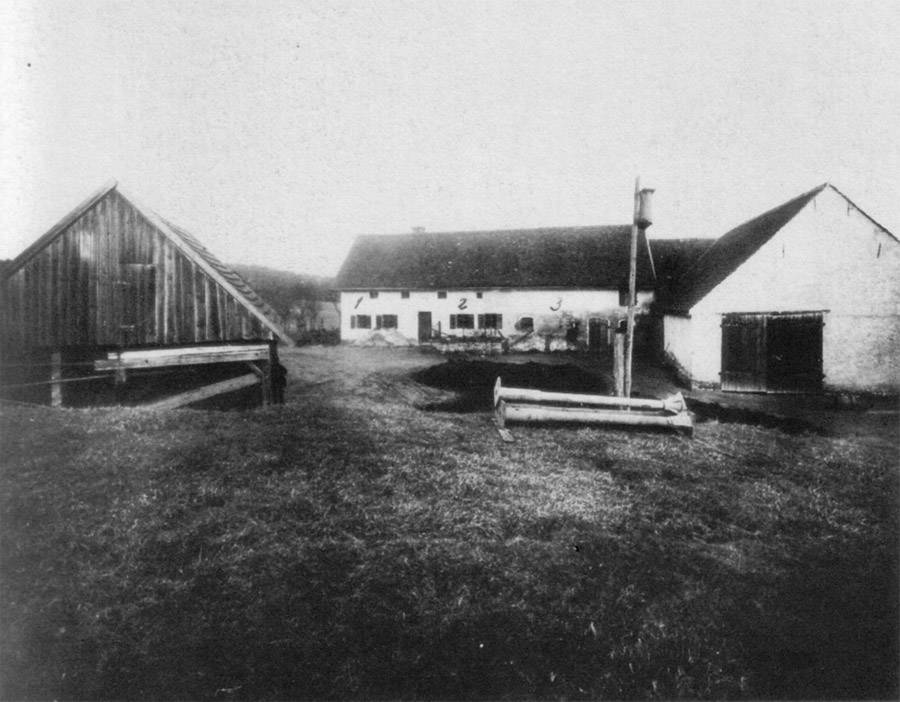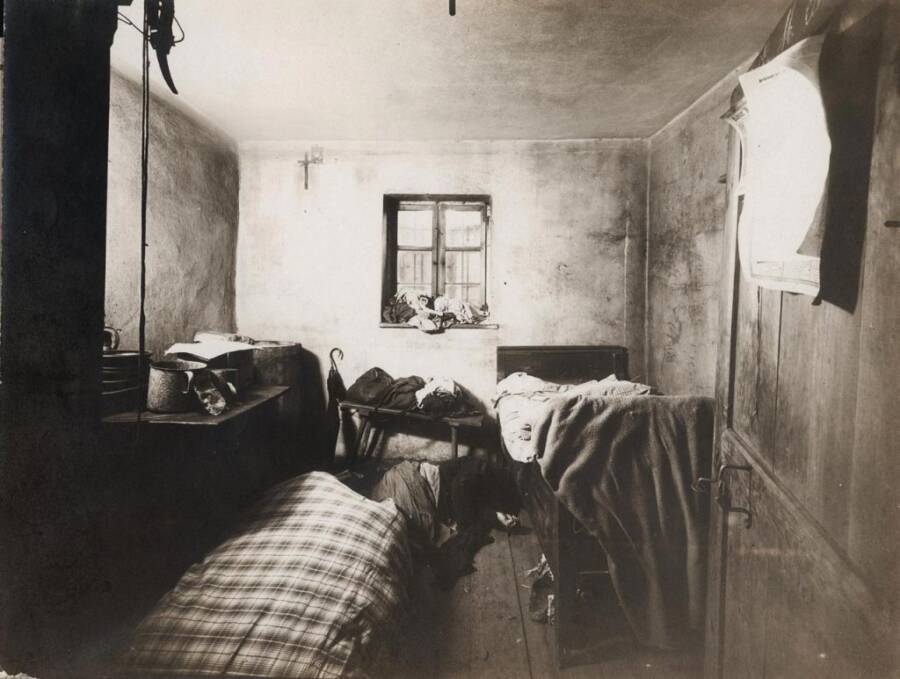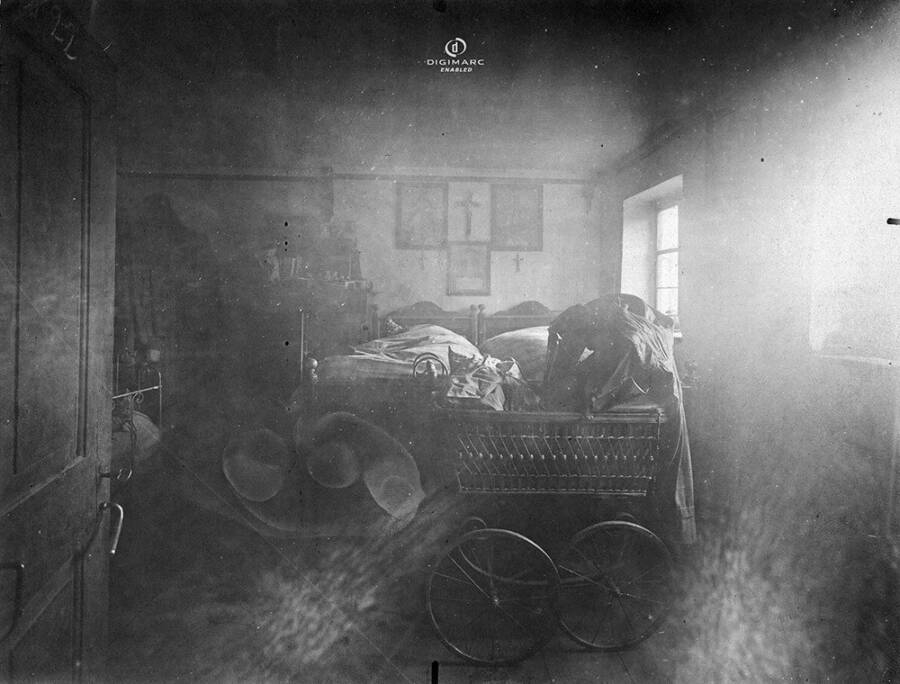On March 31, 1922, a mysterious killer murdered a German family of five — Andreas and Cäzilia Gruber, their daughter Viktoria Gabriel, Viktoria's children Cäzilia and Josef — and the family's maid Maria Baumgartner. To this day, the killer has never been identified.

Wikimedia CommonsThe family farmhouse where the Hinterkaifeck Murders would take place.
About a week before March 31, 1922, farmer Andreas Gruber noticed something strange on his farmstead, known locally as Hinterkaifeck. Outside, he found footsteps leading from the woods behind the farm leading towards the home — but none leading away from it.
Gruber never reported the footsteps to the police, as the small German farm, located about 43 miles north of Munich, was a relatively quiet and safe place. If he had, the Grubers might have avoided the gruesome and mysterious crime that befell them.
On March 31, an unknown person — or potentially multiple people — killed each of the six members of the Gruber household. Andreas, his wife Cäzilia, their adult daughter Viktoria, and their granddaughter Cäzilia Gabriel were all lured to the barn and slaughtered inside with a pickaxe. The family maid, Maria, and their baby grandson Josef were murdered in the home in their bedchambers.
And over 100 years later, the mysterious Hinterkaifeck murders remain unsolved.
The Strange Events At The Hinterkaifeck Farm

Public DomainThe Gruber family.
Prior to the Hinterkaifeck murders, there had been a number of strange occurrences on the farmstead that could have indicated that something was afoot.
The year before, the family’s maid had quit, with rumors spreading that she left out of fear that the house was haunted after hearing odd noises in the attic, according to Mental Floss.
Then, in March 1922, Andreas Gruber found a newspaper from Munich on the farmstead — one that he had no recollection of buying. At first, he believed that it may have been a mix-up on the part of the postman, but it was later revealed that no one nearby subscribed to this specific paper.
Of course, there were also the footprints that Gruber found less than a week before the murders. Neighbors later recalled that Gruber had also been complaining about hearing footsteps in the attic, though when he went to investigate, he found no one.
Still, no one could have predicted the horrific events that would soon follow.
The Grisly Scene Of The Hinterkaifeck Murders

Public DomainThe maid’s quarters at the Hinterkaifeck farmstead.
Eventually, the Gruber family found a new maid. Maria Baumgartner arrived at the family’s farm on the ill-fated day of March 31, 1922, dropped off by her sister — likely the last person to have seen the family and their new maid alive.
That very evening, the members of the Gruber family and Maria Baumgartner would be murdered, but it was days before this horrific scene was discovered.
The next day, a couple of locals stopped by the Hinterkaifeck farm but did not find it overly suspicious that the family did not answer — they had a reputation for keeping to themselves.
Days passed. Mail continued to pile up. Alarmingly, young Cäzilia Gabriel had failed to show up for school, with no excuse from her parents. The family, who would normally be found at church every Sunday, also failed to show up for worship.
Eventually, word began to spread, and on April 4, according to an archived post from the German site Donaukurier, a neighbor by the name of Lorenz Schlittenbauer arrived at the property along with two other men to look for the Grubers.

Public DomainThe bodies discovered in the Hinterkaifeck barn.
They, like previous visitors, found the farm eerily quiet and seemingly devoid of life. This latter suspicion would ultimately be confirmed when the men came to the stable to discover four bodies dead in the hay.
They quickly realized that the bodies had belonged to Andreas Gruber, his wife Cäzilia, his daughter Viktoria Gabriel, and the seven-year-old Cäzilia Gabriel. Soon enough, they found the bodies of Maria Baumgartner and the family’s youngest member, Josef, inside the house.
The men alerted local police, and though the investigation brought several disturbing key details to light, police were never able to capture, or even identify, the killer.
The Maddening Investigation Into The Mysterious Tragedy
Investigators initially believed the motive for the murders may have been a robbery gone awry, but there were a number of things that hampered the investigation from the onset. Firstly, several people had tampered with the crime scene, moving the bodies and even going as far as to cook in the home’s kitchen.

Public DomainA crime scene photograph from the Hinterkaifeck case of the room where Josef was killed.
Secondly, the crime scene itself didn’t offer any clues as to a true motive. The robbery theory was thrown out when police discovered a decent amount of money in the home still, and it was clear that whoever the murderer had been, they had stayed on the farm for several days. The animals were still being fed, and the family’s food had been eaten.
Per a report from the German site Augsburger Allgemeine, police at the time also failed to secure any fingerprints from the crime scene. The farmstead itself was also razed shortly after the murders, making it near impossible to find any useable DNA evidence from the crime scene.
Even after 100 years of analysis, and worldwide attention, little is known about the Hinterkaifeck murders, in terms of motive at least. Technical college students from the Police University of Applied Sciences in Fürstenfeldbruck conducted an analysis of the crime in 2007, ultimately drawing the conclusion that “The crime was triggered by a personal, emotional conflict.”

Sueddeutsche Zeitung Photo / Alamy Stock PhotoA memorial dedicated to the Gruber family at the former site of their farmstead.
Still, that doesn’t do much to help identify the culprit or culprits. There were several prominent suspects at the time, including Viktoria Gabriel’s own late husband, who some claimed had not actually died during the First World War.
Disturbing details about the Gruber family have also come to light in the century since their murders. For example, in 1914, Andreas Gruber was sentenced to one year in prison for incest – and Viktoria was sentenced to one month in prison. This was the same year that Viktoria’s husband Karl supposedly died in France.
Yet Cäzilia Gabriel was born in 1915, and Josef in 1919. It’s possible that Josef’s father could have been a temporary lover of Viktoria’s — but some have suggested that he may have in fact been the result of an incestuous relationship between Viktoria and Andreas.
Some theories claim that Karl Gabriel had not actually died, then discovered the relationship between his wife and her father, and killed the family in a fit of rage. Others have put forth a similar story, replacing Karl Gabriel with Viktoria’s possible lover — who may or may not have been Lorenz Schlittenbauer, the man who originally discovered the bodies.
Schlittenbauer’s actions following the discovery certainly called his credibility into question, especially his disturbing the bodies at the crime scene. However, his connection here was never proven.
Ultimately, any leads investigators have had over the years led only to dead ends. The case was officially closed in 1955, though interrogations continued up through 1986, when chief investigator Konrad Müller retired, never having gotten any closer to finding an answer.
Enjoy this article on the Hinterkaifeck murders? Next, read about more unsolved murders, like the unsolved Redhead Murders, and the Tylenol Murders.





